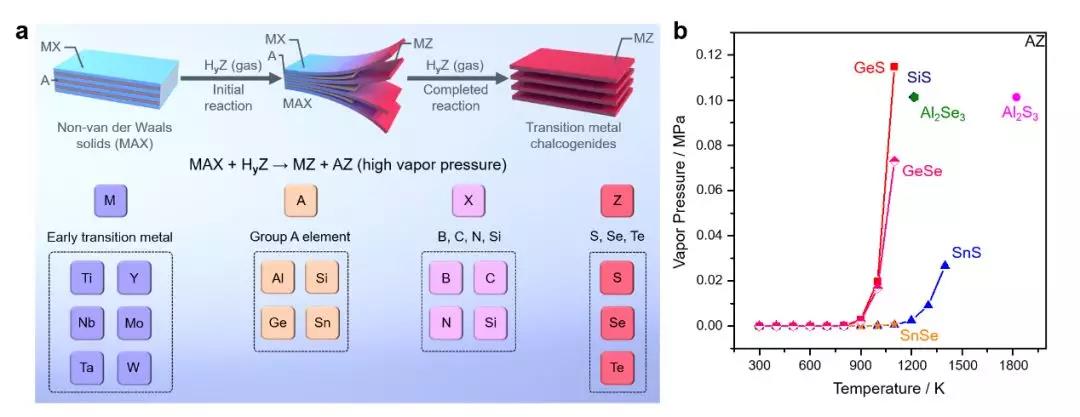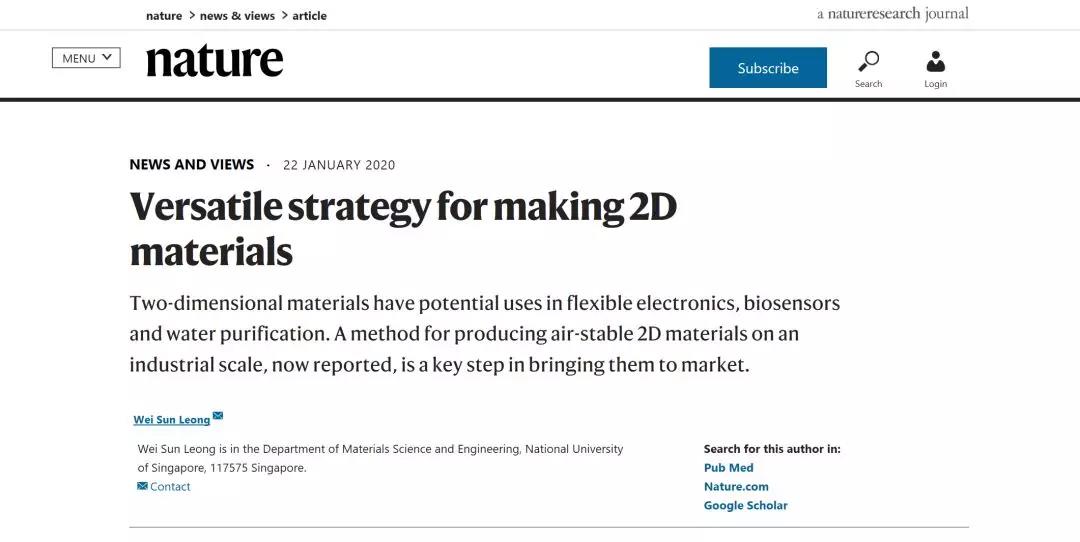
hotline:
17715390137
Tel/Wechat:
18101240246 (Technology)
0512-68565571
Email:mxenes@163.com (Sales Engineer)bkxc.bonnie@gmail.com
Scan the code to follow or search the official account on WeChat:
2D Materials Fronrier After paying attention,
click on the lower right corner to contact us,
Enter enterprise WeChat.
Professional Services Online

Facing the epidemic, you can live in peace
Can you send paper at home?
Beihang people posted a Nature at home!
The first author is a doctoral student of Beihang University
Corresponding author is Professor Beihang
The first completed unit is Beihang
Take a look at this Nature that overcomes international problems
Recently, "Nature" magazine published the full-text article on the latest progress made by Professor Yang Shubin‘s group at the School of Materials Science and Engineering, Beijing University of Aeronautics and Astronautics in the research of single-layer two-dimensional materials.
"Conversion of non-van der Waals solids to 2D transition-metal chalcogenides" discovers and proposes a new method for synthesizing single-layer two-dimensional materials-the topological transformation method. Carbon nitride (MAX phase), etc.) directly produce a large number of monoatomic layers of two-dimensional transition metal chalcogenides with ultra-stable and ultra-high monolayer ratios, which overcomes the international difficulties of single-layer two-dimensional materials that are difficult to prepare and unstable. , The prepared two-dimensional monoatomic material has broad application prospects in the fields of electronic devices, optoelectronic devices, catalysis and energy storage (Nature 577, 492-496 (2020)).

Author: Du Zhiguo (Northern 2015 doctoral students)
Corresponding author: Yang Shubin Pulickel M. Ajayan
First unit: Beijing University of Aeronautics and Astronautics, School of Materials Science and Engineering
Single-layer two-dimensional materials such as two-dimensional transition metal chalcogenides are composed of transition metal atoms and chalcogen atoms. Due to their unique two-dimensional structure, they have broad application prospects in many fields such as electronic devices, catalysis, and energy storage. Traditionally, two-dimensional transition metal chalcogenides are generally prepared by a "top-down" synthesis method typified by mechanical stripping, liquid-phase stripping, and electrochemical stripping methods, and a "bottom-down" typified by chemical vapor deposition. And above "preparation method. However, the yield / single-layer rate of 2D transition metal chalcogenides synthesized by these methods is extremely low (<1%), and the structure (especially 1T phase) is unstable, which severely limits the application of 2D materials.
Professor Yang Shubin and others proposed a new method for synthesizing two-dimensional materials, the topological transformation method. By gradually transforming non-Vandvard solids (transition metal carbides, nitrides, and carbonitrides (MAX phase), etc.), a large number of super stable and The single atomic layer two-dimensional transition metal chalcogenide with ultra-high single-layer ratio overcomes the international difficult problems of single-layer two-dimensional materials that are difficult to prepare and unstable. Taking the MAX phase for the synthesis of two-dimensional transition metal chalcogenides as an example, researchers have reacted the MAX phase with a chalcogen-containing gas or vapor (sulfur, hydrogen sulfide, selenium, etc.) HyZ (y = 0, 2) (Figure ( a)), because the MX bond in the MAX phase is a strong ionic or covalent bond, and the MA bond is a weaker metal bond, therefore, at high reaction temperatures (873-1373K), Phase A will react with chalcogen-containing gas to generate a gaseous product (AZ) with a higher vapor pressure from the reaction system (Figure (b)), and phase M will react accordingly to form a two-dimensional with a specific accordion structure. Transition metal chalcogenide (MZ). Studies have revealed that this topological transformation is controlled by the enthalpy and vapor pressure of the reaction products. By adjusting the composition of the MAX phase (ternary or quaternary MAX phase) and introducing a third reactant (phosphorus vapor) into the reaction system, it is possible to synthesize a high monolayer ratio (~ 30%) and ultrahigh temperature stability (> 1000oC) two-dimensional transition metal chalcogenide (2H / 1T phase). When a layered transition metal carbide (Mo2C) is used as a reactant, MoS2 with an extremely high single-layer rate (~ 90%) can be synthesized, which overcomes the difficulty of preparing a single-layer two-dimensional material.

Figure (a): The mechanism of the conversion of non-Vandvard solids (MAX phase) to the synthesis of ultra-high monolayer and high-temperature stable two-dimensional transition metal chalcogenide
Figure (b): Saturated vapor pressure-temperature curve of the intermediate formed by phase A and chalcogen-containing gas or vapor in the MAX phase
By topologically transforming non-van der Waals solids, the researchers synthesized 14 transition metal chalcogenides with a controllable phase structure and ultra-high single-layer rate, including 7 transition metal chalcogenides Ti5S8, TiSe2, NbS2, NbSe2, MoS2, MoSe2, TaS2, 5 kinds of doped transition metal chalcogenide Y doped WS2, Nb doped TiSe2, Y, P co-doped WS2, P doped MoS2, P doped TiSe2, 1 compound MoSe2 / TiSe2. This topology conversion method will become the third method in addition to traditional Top-down and Bottom-up. It is expected to synthesize a series of ultra-high single-layer rates and high-temperature stable Van der Waals two-dimensional materials on a large scale. Electronic devices and other fields have broad application prospects.
At the same time, Professor Wei Sun Leong of the National University of Singapore reviewed the work of Beihang Yang Shubin and published it in Nature. It is pointed out in the review that this method can directly transform non-Vandva solid materials into single-layer TMCs. It is extremely universal, easy to operate, and low in cost. It is very suitable for industrial production, and greatly promotes the application of two-dimensional materials to the market. commercialize. From the perspective of science itself, the latest research worksheet by Professor Yang Shubin‘s team shows that the doping of small (<1%) heteroatoms can stabilize single-layer transition metal chalcogenides and is used to solve the instability of two-dimensional materials in the environment. This provides new ideas for materials researchers: we should begin to explore the use of chemical elements to stabilize two-dimensional materials without using complex strategies such as cladding.

Professor Wei Sun Leong of the National University of Singapore commented on the work of Beihang Yang Shubin and published it in Nature

This work was jointly completed by 11 collaborators from 4 units: Beihang Yang Shubin‘s research team and Professor Rice‘s Pulickel M. Ajayan‘s research team, Tsinghua University Shenzhen Graduate School‘s research team Professor Song Li‘s research group. This work uses a variety of advanced testing and characterization methods for single-layer 2D materials. This work was mainly supported by the National Natural Science Foundation of China‘s outstanding youth project and general project (51622203, 51572007) and the Ministry of Education‘s 111 Introducing Intelligence Program (B17002).
Original article link:
https://www.nature.com/articles/s41586-019-1904-x

| Reminder: Beijing Beike New Material Technology Co., Ltd. supplies products only for scientific research, not for humans |
| All rights reserved © 2019 beijing beike new material Technology Co., Ltd 京ICP备16054715-2号 |